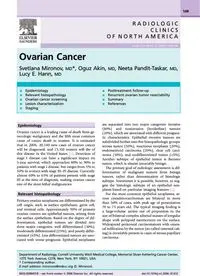
07 - Radiol Clin N Am 2007 - Ovarian Cancer PDF
Preview 07 - Radiol Clin N Am 2007 - Ovarian Cancer
Ovarian Cancer Svetlana Mironov, MD*, Oguz Akin, MD, Neeta Pandit-Taskar, MD, Lucy E. Hann, MD Epidemiology Ovarian cancer is a leading cause of death from gy- necologic malignancy and the fifth most common cause of cancer death in women. It is estimated that in 2006, 20,180 new cases of ovarian cancer will be diagnosed, and 15,310 women will die of this disease in the United States [1]. Detection of stage I disease can have a significant impact on 5-year survival, which approaches 80% to 90% in patients with stage I disease, but ranges from 5% to 50% in women with stage III–IV disease. Currently, almost 60% to 65% of patients present with stage III at the time of diagnosis, making ovarian cancer one of the most lethal malignancies. Relevant histopathology Primary ovarian neoplasms are differentiated by the cell origin, such as surface epithelium, germ cell, and stromal cells. Approximately 90% of primary ovarian cancers are epithelial tumors, arising from the surface epithelium. Based on the degree of dif- ferentiation, epithelial tumors are divided into three major categories: well differentiated (10%), moderately differentiated (25%), and poorly differ- entiated (65%). Less differentiated tumors are asso- ciated with worse prognosis. Epithelial neoplasms are separated into two major categories: invasive (80%) and noninvasive (borderline) tumors (20%), which are associated with different prognos- tic characteristics. Epithelial invasive tumors are subdivided further into five histopathologic groups: serous tumor (50%), mucinous neoplasm (20%), endometrioid carcinoma (20%), clear cell carci- noma (10%), and undifferentiated tumor (<5%). Another subtype of epithelial tumor is Brenner tumor, which is almost invariably benign. The primary goal of radiologic assessment is dif- ferentiation of malignant tumors from benign tumors, rather than determination of histologic subtype. Sometimes it is possible, however, to sug- gest the histologic subtype of an epithelial neo- plasm based on particular imaging features [2]. For the most common epithelial neoplasms, se- rous cystadenocarcinomas are bilateral in more than 50% of cases, with peak age of presentation 70 to 75 years old. The typical imaging finding is a large-volume ascites out of proportion to the size of bilateral complex adnexal masses of irregular shape with polypoid excrescences on the surface. Widespread peritoneal carcinomatosis with omen- tal infiltration by the tumor (so-called omental cak- ing) is invariably present in cases of serous papillary carcinoma. R A D I O L O G I C C L I N I C S O F N O R T H A M E R I C A Radiol Clin N Am 45 (2007) 149–166 Department of Radiology, Cornell University Weill Medical College, Memorial Sloan-Kettering Cancer Center, 1275 York Avenue, C278, New York, NY 10021, USA * Corresponding author. E-mail address:
